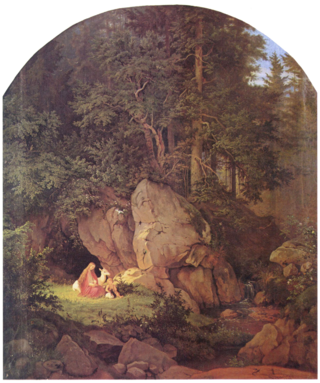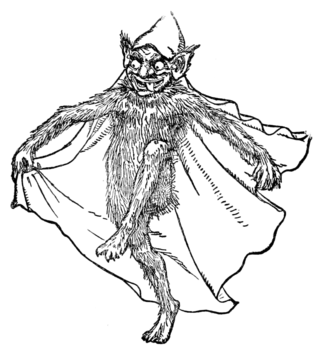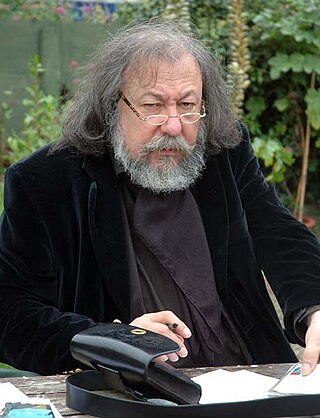
A fairy is a type of mythical being or legendary creature, generally described as anthropomorphic, found in the folklore of multiple European cultures, a form of spirit, often with metaphysical, supernatural, or preternatural qualities.
Fairies, particularly those of Irish, English, Scottish and Welsh folklore, have been classified in a variety of ways. Classifications – which most often come from scholarly analysis, and may not always accurately reflect local traditions – typically focus on behavior or physical characteristics.
A sprite is a supernatural entity in European mythology. They are often depicted as fairy-like creatures or as an ethereal entity.

In fairy tales, a fairy godmother is a fairy with magical powers who acts as a mentor or parent to someone, in the role that an actual godparent was expected to play in many societies. In Perrault's Cinderella, he concludes the tale with the moral that no personal advantages will suffice without proper connections.
The wulver or wullver is a kind of wolf-like humanoid creature in the folklore of the Shetland Islands of Scotland. In modern times, the origin of the wulver has been disputed.

Glashtyn is a legendary creature from Manx folklore.

In folklore and fantasy, an enchanted forest is a forest under, or containing, enchantments. Such forests are described in the oldest folklore from regions where forests are common, and occur throughout the centuries to modern works of fantasy. They represent places unknown to the characters, and situations of liminality and transformation. The forest can feature as a place of threatening danger, or one of refuge, or a chance at adventure.
Arkan sonney is the Manx term for hedgehog. In Manx folklore it is a type of fairy animal that takes the form of a white pig that brings good fortune to those who manage to catch it. It was even considered a favourable omen just to have seen the "lucky piggy". It was also said that if you caught one you would always find a silver coin in your pocket. However, holding on to it for too long will result in bad fortune.
Maggy Moulach is a character from Scottish folklore said to be a Highland brownie. According to the folklore, she had a son named Brownie-Clod, who was said to be a dobie. A dobie is a somewhat dull-witted, though well-intentioned, variety of brownie.
The asrai is a type of aquatic fairy in English folklore and literature. They are usually depicted as female, live in lakes and are similar to the mermaid and nixie. Rather than originating from folklore, the asrai may have been invented by the Scottish poet Robert Williams Buchanan.

A hag is a wizened old woman, or a kind of fairy or goddess having the appearance of such a woman, often found in folklore and children's tales such as "Hansel and Gretel". Hags are often seen as malevolent, but may also be one of the chosen forms of shapeshifting deities, such as The Morrígan or Badb, who are seen as neither wholly benevolent nor malevolent.

A goblin is a small, grotesque, monstrous creature that appears in the folklore of multiple European cultures. First attested in stories from the Middle Ages, they are ascribed conflicting abilities, temperaments, and appearances depending on the story and country of origin, ranging from mischievous household spirits to malicious, bestial thieves. They often have magical abilities similar to a fairy or demon, such as the ability to shapeshift.

Pierre Dubois, is a French specialist in fairy tales and folklore. He is an author, Franco-Belgian comics scriptwriter, and lecturer on fairies and little people in France. His style of fantasy is primarily Anglo-Saxon, after the manner of authors such as Bram Stoker, Mary Webb and Charlotte Brontë. He coined the term elficology (elficologie) as a name for the study of the "little people", originally as a joke. Fascinated at a young age by fairy tales and fairytale fantasy, he became an illustrator after studying the fine arts for a short period. His first comic book was published in 1986. Since then he has produced one comic book a year and made regular appearances on television and at conferences relating to fairy tales, dreams, and legends related to fairies. Because of his encyclopedias of fairies, imps, and elves, published in the 1990s, Dubois won international recognition as a French specialist in magic.

Édouard Brasey is a French novelist, essayist, scriptwriter and story-teller born on 25 March 1954. Author of more than seventy works, many of which have been translated into English, Russian, Japanese, Spanish, Portuguese and Italian. He specialises in the themes of the esoteric, fables, legends and fantasy. He won a prize of Imaginales in 2006 for La Petite Encyclopédie du Merveilleux, and a prize Merlin in 2009 for his novel La Malédiction de l'Anneau. Subsequently, he has become essentially a novelist, notably published by Calmann-Lévy. His historical-esoteric thriller that was published in 2013, Le Dernier Pape, anticipated the abdication of Benoît XVI.

A groac'h is a kind of Breton water-fairy. Seen in various forms, often by night, many are old, similar to ogres and witches, sometimes with walrus teeth. Supposed to live in caverns, under the beach and under the sea, the groac'h has power over the forces of nature and can change its shape. It is mainly known as a malevolent figure, largely because of Émile Souvestre's story La Groac'h de l'île du Lok, in which the fairy seduces men, changes them into fish and serves them as meals to her guests, on one of the Glénan Islands. Other tales present them as old solitary fairies who can overwhelm with gifts the humans who visit them.

Lou Drapé is a legendary folkloric horse of the town of Aigues-Mortes in the Gard region, in the Petite Camargue marsh area of France. It is said to wander around the walls of the city at night and to take a large number of children on his back to abduct them. These children never return from this journey.
Sleih beggey is the umbrella term for Manx fairies.
Fions are lutin-like creatures of the little people, mostly mentioned in the maritime folklore of Upper Brittany. They might be of English origin. Most of the stories about them come from Paul Sébillot's collections in the late 19th century. Characterized by their habitat in the rocks and caves of Brittany's northern shores, the Fions lead a military life in community with the houles fairies, as their servants. Organized into battalions, they are said to wage war on a golden ship. According to tales, they own and graze livestock, and sometimes give enchanted objects or food to humans. Pierre Dubois and Joann Sfar featured a Fion in the comic strip series Petrus Barbygère, in 1996 and 1997.

The legendary horses of Pas-de-Calais are fabulous, diabolical white animals, mentioned in the folklore of Artois, Ternoise and Boulonnais under various names. The blanque mare is said to appear at dusk or in the middle of the night to deceive children and men. She would tempt the latter to ride her, and her back could stretch to accommodate, usually, up to seven riders. Once they had settled on her back, she would lure them into traps or throw them into the water. This animal is also mentioned under the same name in Samer.











